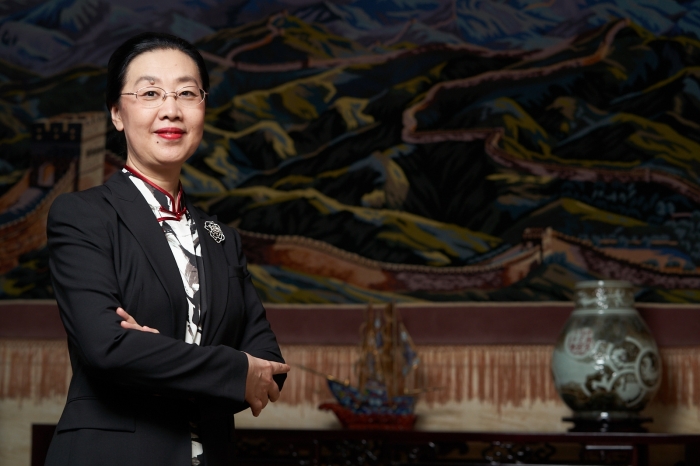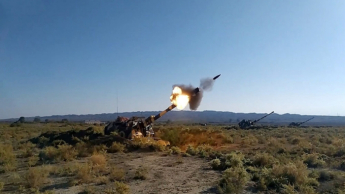Guo Min: Zangezur corridor will play an active part in promoting peace and stability for the region - Exclusive interview

Baku Tribune’s interview with the Ambassador of the People's Republic of China to the Republic of Azerbaijan Ms. Guo Min.
Baku Tribune’s interview with the Ambassador of the People's Republic of China to the Republic of Azerbaijan Ms. Guo Min.
- Recently, President Xi Jinping of China attended, via video link, the Leaders Summit on Climate and delivered an important speech. Please brief us on the positions and propositions of China.
- Invited by the U.S. President, Mr. Biden, President Xi Jinping attended, via video link, the Leaders Summit on Climate, hosted by the U.S., and delivered an important speech in which he expounded for the first time on the content and core of the notion of “a community of life for man and Nature.” It can be summed up in the Six Commitments: first, the commitment to harmony between man and Nature; second, the commitment to green development; third, the commitment to systemic governance; fourth, the commitment to a people-centered approach; fifth, the commitment to multilateralism; sixth, the commitment to the principle of common but differentiated responsibilities.
The Six Commitments reflect President Xi Jinping’s extraordinary insight into how human beings should respond to the climate change and properly handle the relations between man and Nature to realize sustainable development for all mankind. They are also a demonstration of the breadth of China’s vision as it participates in the global climate and environmental governance.
Being a participant, contributor, and leader in the construction of global ecological civilization, China has made concrete and relentless efforts in building a community of life for man and Nature. President Xi Jinping reiterated that China will strive to peak its carbon dioxide emissions before 2030 and achieve carbon neutrality before 2060, which is a major strategic decision based on China’s responsibilities for building a community of shared future for mankind and the requirements inherent in sustainable development. China has committed itself to moving from carbon peak to carbon neutrality in a period far shorter than the plans of developed countries and is determined and confident that it shall live up to its commitment.
China will continue to implement state strategies in a conscious effort to tackle climate change and stick to green development and the transformation towards a low-carbon economy. It will include the cooperation in the field of ecological civilization as a key part of the Belt and Road cooperation, and launch a series of green action initiatives, covering wide-rangeing efforts in green infrastructure, green energy, green transport and green finance. The aim of these efforts is to bring enduring benefits to the people of all Belt and Road partner countries while making China’s own contributions to promoting a multilateral framework for global climate governance and building a community of life for man and Nature.
- According to the latest data published by the Ministry of Commerce of China in the first quarter of this year, the volume of China’s non-financial outbound direct investment in the Belt and Road partner countries has achieved a year-on-year increase of 5.2%. How would you evaluate the Belt and Road cooperation in the context of the global effort to combat the pandemic and realize economic recovery?
- In 2013, President Xi Jinping proposed the Belt and Road Initiative. For seven years since then, China has signed more than 200 BRI cooperation documents with 140 countries and 31 international organizations. As BRI development advances, a large number of key cooperation projects have taken root, which has strengthened trade and investment flows and connectivity between different countries, created jobs for tens of thousands of people, and made significant contributions to local economic development and improvement of livelihoods.
The first quarter of this year has seen a steady rise in investment cooperation between China and countries along the Belt and Road. The contractual value and turnover of newly signed EPC contracts are up by 19.4% and 12.4% respectively, compared to last year. There have been a total of 3,398 China Railway Express trips to Europe, carrying 322 thousand twenty-feet equivalent units of cargo, representing a year-on-year increase of 75% and 84% respectively. Such achievements are even more hard-won against the tremendous challenge of a rampant pandemic and economic recession.These impressive figures reflect the strong driving force behind the BRI.
During the pandemic, the Belt and Road cooperation has played an important role in safeguarding the life and health of the people of various countries. The China-Europe Railway Express served as an important logistics channel for transporting anti-pandemic supplies. A total of 11.046 million anti-pandemic items have been sent out by the end of March 2021. We have participated in the joint vaccine production with our Belt and Road partners, such as Indonesia, UAE, Malaysia, Pakistan and Turkey, and expanded cooperation with various partners in fields including prevention and control of infectious diseases, public health, and traditional medicine.
The Belt and Road Initiative has become an immensely popular global public good, the largest platform for cooperation and a broad avenue for shared progress.China has every intention to work with all parties for solid progress in high-standard, people-centered and sustainable BRI development to contribute to the stability and prosperity of countries along the routes.
-Together, the Baku International Sea Trade Port and the Baku–Tbilisi–Kars railway form the shortest east–west transportation route across Eurasia that enables cargoes departing from China to reach Europe in just 12 days. How would you evaluate China’s cargo-carrying potential with the Baku–Tbilisi–Kars railway?
- The Baku–Tbilisi–Kars railway forms an integral part of the the Belt and Road cooperation as well as serving as a key bridge that connects the eastern and western ends of Eurasia. In recent years, a number of China-Europe Railway Express routes have been launched, including the Xi’an-Baku, the Jinhua-Baku, and the Qingdao-Baku routes. Through these routes, a variety of Chinese cargoes, such as mechanical equipment, household appliances, tools, hardware, and tyres, are delivered to Azerbaijan, from where they are transported to Europe via the Baku–Tbilisi–Kars railway. This has effectively boosted the trade between China and Azerbaijan and between China and Europe.
Against the background of a tangible downturn in international ocean shipping and air transportation as a result of the global pandemic, the China–Europe Railway Express has maintained a strong momentum of growth. Statistics from China suggest that in 2020, the China–Europe Railway Express gave full play to its unique advantages of being international through railway transport and took on a substantial volume of cargoes delivered by sea and air. A total of 12,406 trips were conducted throughout the year, up by 50% compared to the previous year. This figure rose above the symbolic 10 thousand trips threshold for the first time and was 7.3 times more than that of 2016. We are convinced that as the world economy recovers, the cargo-carrying potentials of the Baku–Tbilisi–Kars railway will improve further, and there will be better prospects for future cooperation in transportation and logistics between China and Azerbaijan.
- Currently, Azerbaijan is devoted to building a new corridor for cross-border transportation that is designed to cut through the territory of Armenia to join up the Azerbaijan mainland and the Autonomous Republic of Nakhchivan (Zanegzur corridor). For China, this corridor will serve as the second South Caucasus route leading to Europe via Armenia, Nakhchivan, and Turkey. Do you think that this new corridor of transportation will have anything to contribute to the Belt and Road cooperation?
- The region of the Southern Caucasus lies right on the median of the Silk Road Economic Belt. Endowed with geological advantages, the countries in this region are key partners who actively support the Belt and Road cooperation. Building the new corridor for transportation to Europe via Armenia, Nakhchivan, and Turkey is a major step taken in alignment with the joint Statement on the ceasefire in Nagorno-Karabakh implemented among Azerbaijan, Armenia, and Russia, and will play an active part in promoting peace and stability for the region.
As pointed out by President Xi Jinping, the Belt and Road Initiative is a public road open to all, not a private path owned by one single party. Belt and Road cooperation pursues development, aims at mutual benefits, and conveys a message of hope. We are ready to work with all parties and strive to connect the new corridor for transportation with the Belt and Road to realize common development through win–win cooperation.
The autor is Seymur Mammadov
The Rocket and Artillery formations of the Azerbaijan Army conduct live-fire exercises in accordance with the combat training plan for 2021, the Ministry of Defense of Azerbaijan told Baku Tribune.
LAST NEWS






.jpg&h=67&w=67&zc=1&q=100)













